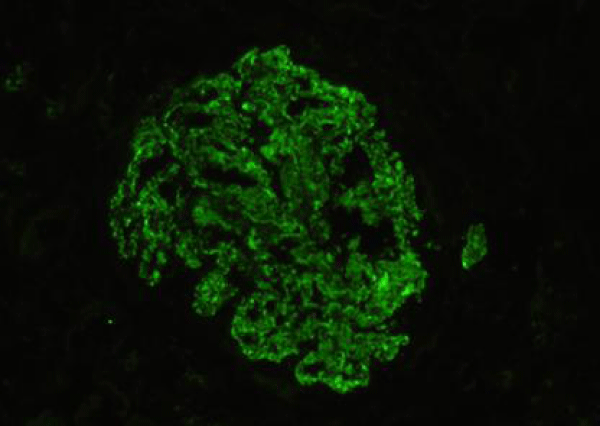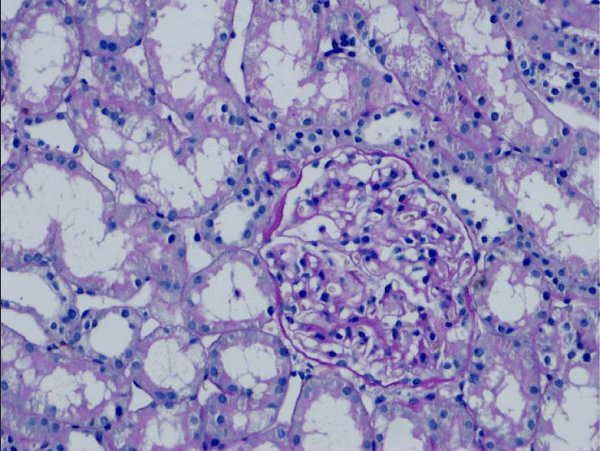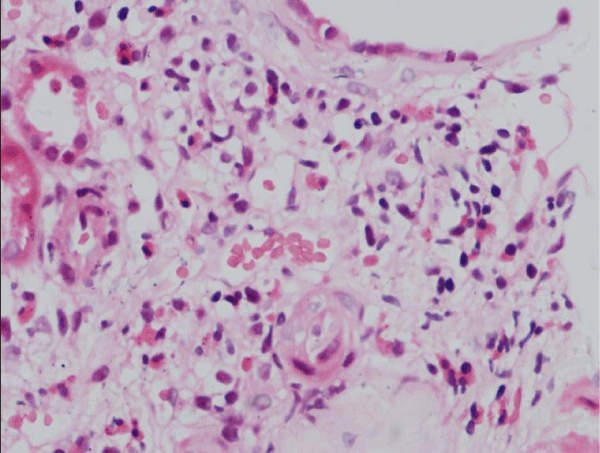
Case Report
Austin J Nephrol Hypertens. 2014;1(2): 1007.
Idiopathic Hypereosinophilic Syndrome in a Patient with Nephrotic Syndrome: A Case Report
Hai-Feng Ni, Kun-Ling Ma*, Yan Li Wang, Ri Ning Tang, Yan Tu, Hong Liu, Xiao Liang Zhang and Bi Cheng Liu
Department of Nephrology, Southeast University School of Medicine, China
*Corresponding author: Kun-Ling Ma, Department of Nephrology, Zhong Da Hospital, Southeast University School of Medicine, Nanjing City, Jiangsu Province, 210009, China
Received: July 08, 2014; Accepted: July 18, 2014; Published: July 21, 2014
Abstract
Background: Renal involvement in idiopathic hypereosinophilic syndrome is rarely reported, and little is known about the renal morphologic changes and their clinical course.
Case presentation: A 25-year-old Chinese man presented with nephrotic syndrome three years ago in the renal department of our hospital. His white blood cell count was 12.49 x 109/L ~ 14.20 x 109/L blood eosinophils were 37% ~ 43%, and the blood eosinophilia count was 5.29 x 109/L ~ 6.24 x 109/L. There was no clinical evidence of eosinophil increase induced by secondary factors; no obvious anomalies were observed with respect to the chromosomes or gene fusions. Renal biopsy puncture was performed, and histopathological examination demonstrated mild endocapillary proliferation, irregularly thickened glomerular capillary walls and lymphoid and eosinophilic infiltration in the renal tubulointerstitium. Glucocorticoid therapy was effective; during the two-year follow-up, no recurrence of the mass was observed, and the patient had no proteinuria.
Conclusion: The clinical manifestation of idiopathic hypereosinophilic syndrome lacks specificity, and the diagnosis needs comprehensive examinations to exclude an increase in eosinophils induced by secondary and clonal diseases. Renal involvement in idiopathic hypereosinophilic syndrome should be initially assessed as glucocorticoid therapy can quickly control the pathogenetic condition.
Keywords: Idiopathic hypereosinophilic syndrome; Nephrotic syndrome; Patient
Idiopathic hypereosinophilic syndrome (IHES) is characterised by an increased number of eosinophils in the peripheral blood and tissues in the absence of any known causes of eosinophilia [1]. The disease has a significant male dominance and is usually diagnosed between the ages of 20 and 50 years. There are three diagnostic criteria for IHES: persistent eosinophilia of >1.5×109/L; the exclusion of secondary causes of eosinophilia, including allergic reactions or parasitic infection and ultimately organ damage; and the exclusion of other acute or chronic myeloid neoplasms [2]. Renal involvement in IHES is rarely reported, and little is known about the renal morphological changes and their clinical course. We report a case of IHES with nephrotic syndrome and discuss the clinical and histopathological features of this disease.
Case Presentation
A 25-year-old Chinese man presented with nephrotic syndrome three years ago in the renal department of our hospital. On physical examination, his blood pressure was 130/70 mmHg, and his heart rate was 72/minute. Pitting oedema of the lower limbs was noted, but the remainder of the physical examination was unremarkable. His white blood cell count was 12.49×109/L ~14.20×109/L, blood eosinophils were 37-43%, blood eosinophilia count was 5.29×109/L ~ 6.24×109/L, haemoglobin was 151 g/L ~ 170 g/L, and platelets were 333×109/L ~ 380 ×109/L. His 24-hour urine protein excretion was in the range of 10.2 g/day to 10.7 g/day without haematuria. Albumin was 15 g/L ~19 g/L, and serum creatinine was 75 μmol/L ~ 87 μmol/L. Computerised tomography of the chest was normal as was abdominal ultrasound. Examination of the stool for parasites was negative. Antinuclear, anti-double-stranded DNA, anti-Sm, pANCA, cANCA, anti-RNP, rheumatoid factor, anti-Ro and anti-La antibodies were all negative. C3 and C4 components of the complement system and immunoglobulin A, M and G levels were within normal ranges. Total IgE level was 9580 IU/mL (normal< 200). Venereal disease laboratory slide test (VDRL) and serology for hydatid disease were negative. Bone marrow biopsy was performed, revealing 21.3% eosinophils and immature eosinophil precursors. Marrow blasts were mildly increased, accounting for 8% of the bone marrow differential count. Chromosome studies on the bone marrow aspirate revealed no chromosomal abnormalities. RT-PCR was negative for the FIP1L1-PDGFRA transcript. There was no T-cell population with an abnormal phenotype. A percutaneous kidney biopsy specimen revealed mild mesangial proliferation and lymphoid and eosinophilic infiltration in the renal tubulointerstitium (Figure 2 and Figure 3). There were IgM epimembranous deposits upon immunofluorescence microscopy examination (Figure 1). Based on the medical record, physical examination findings and laboratory data, the patient was diagnosed as having IHES involvement of renal injury. He was given prednisone 70 mg daily (1 mg/kg/d), Amlodipine besylate and Atorvastatin calcium tablets (5 mg once a day) and caltrate (0.6 once a day). The prednisone dose was progressively tapered after 2 weeks. One month after beginning treatment, his white blood cell count decreased to 12.0×109/L and eosinophils to 0.45×109/L; proteinuria decreased to 0.7 g/day. Two months later, his white blood cell count was 18.70×109/L, blood eosinophils were 0.6%, blood eosinophilia count was 0.11×109/L, haemoglobin was 151 g/L, and albumin was 28 g/L. His 24-hour urine protein excretion was in the range of 0.035 to 0.048 g/day.
Figure 1: Immunofluorescence staining for anti-IgM showing diffuse global staining of glomerular capillary walls (Original magnification × 400).
Figure 2: Periodic acid Schiff staining (PAS) staining showing mild mesangial proliferation (Original magnification × 200).
Figure 3: Haematoxylin-eosin (HE) staining showing lymphoid and eosinophilic-infiltrated renal tubulointerstitium (Original magnification 400).
Discussion
Kidney disease is thought to be rare in IHES. According to previous reports, kidney involvement in IHES can present as proteinuria or renal failure [3,4]. Mesangial expansion [5], a thickened glomerular basement membrane [3], proliferative glomerulonephritis [6], crescentic glomerulonephritis [7], immunotactoid glomerulopathy [8], glomerular sclerosis and interstitial nephritis with eosinophilic infiltration [4] are the most common renal histological changes reported. However, there is little information on renal histology in IHES with nephrotic syndrome. In the present case, histopathological examination of the renal biopsy demonstrated mild endocapillary proliferation and irregularly thickened glomerular capillary walls, with lymphoid and eosinophilic infiltration in the renal tubulointerstitium.
Different histopathologic findings have been reported for immunofluorescence microscopy examination of renal biopsy specimens from patients with IHES. Although no immunoglobulin deposits were detected in some cases [4], the presence of immune complex depositions in the kidney was shown by other authors [7]. In the present case, only IgM depositions were found upon immunofluorescence microscopy examination of the biopsy specimen; along with previous reports, our findings may indicate an immunological origin for kidney involvement in IHES.
Although renal involvement in IHES is rare, early diagnosis is essential because a recovery of renal function can be obtained only if treatment is initiated promptly [4]. Because of the well-known eosinopenic effects of corticosteroids, treatment of IHES is initiated with oral prednisone (1 mg/kg/day). The response to steroids differs considerably from case to case, ranging from no response to partial response or, rarely, complete remission [4,6,9]. Cytotoxic agents, such as hydroxyurea or cyclophosphamide, are indicated in patients with rapid progression or a failure to exhibit stabilisation with steroid therapy. Compared with early reported cases of IHES, recent evidence shows a markedly improved 5-year survival rate of 70% ~ 90% [9]. Our patient showed a very good response to oral prednisone, with significant improvement of eosinophilia and complete remission.
In conclusion, to the best of our knowledge, this patient represents the first recorded case of IHES, mild endocapillary proliferation, irregularly thickened glomerular capillary walls, and lymphoid and eosinophilic infiltration interstitial nephritis with immune complex deposits, resulting in nephrotic syndrome resolved by steroid therapy. This diagnosis is expected to result in significant contributions toward the establishment of renal involvement in this disease and clarifying the mechanisms responsible for renal changes.
References
- Trattner H, Breier F, Steiner A, Wruhs M, Feldmann R. Idiopathic hypereosinophilic syndrome with multiple organ infarctions: improvement of the skin condition masking the course of disease. Eur J Dermatol. 2014; 24: 274-275.
- Vardiman JW, Thiele J, Arber DA, Brunning RD, Borowitz MJ, Porwit A, et al. The 2008 revision of the World Health Organization (WHO) classification of myeloid neoplasms and acute leukemia: rationale and important changes. Blood. 2009; 114: 937-951.
- Bulucu F, Can C, Inal V, Baykal Y, Erikçi S. Renal involvement in a patient with idiopathic hypereosinophilic syndrome. Clin Nephrol. 2002; 57: 171-173.
- Motellón JL, Bernis C, García-Sánchez A, Gruss E, Traver JA. Renal involvement in the hypereosinophilic syndrome. Nephrol Dial Transplant. 1995; 10: 401-403.
- Giudicelli CP, Didelot F, Duvic C, Desrame J, Herody M, Nedelec G, et al. [Eosinophilia and renal pathology]. Med Trop (Mars). 1998; 58: 477-481.
- Park SM, Park JW, Kim SM, Koo EH, Lee JY, Lee CS, et al. A case of hypereosinophilic syndrome presenting with multiorgan infarctions associated with disseminated intravascular coagulation. Allergy Asthma Immunol Res. 2012; 4: 161-164.
- Richardson P, Dickinson G, Nash S, Hoffman L, Steingard R, Germain M. Crescentic glomerulonephritis and eosinophilic interstitial infiltrates in a patient with hypereosinophilic syndrome. Postgrad Med J. 1995; 71: 175-178.
- Choi YJ, Lee JD, Yang KH, Woo JY, Kim BK, Bang BK, et al. Immunotactoid glomerulopathy associated with idiopathic hypereosinophilic syndrome. Am J Nephrol. 1998; 18: 337-343.
- Hoffman R, Benz EJ, Shattil SJ, Furie B, Co-hen HJ. Hypereosinophilic syndrome; in Gabig TG (ed): Hematology. Edinburgh, Churchill Livingstone. 1991; 44: 567–571.


